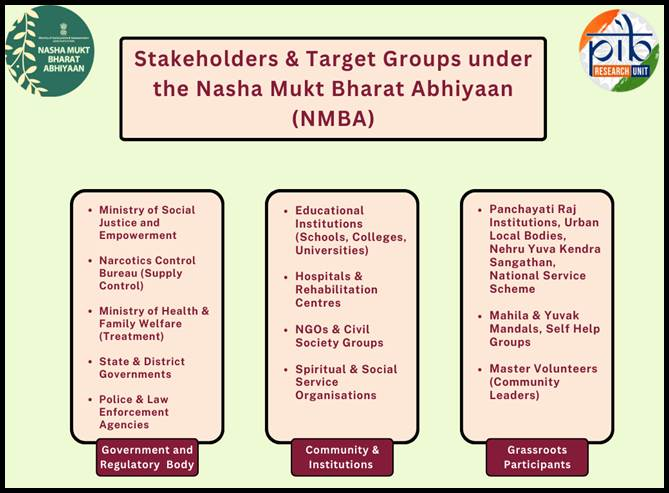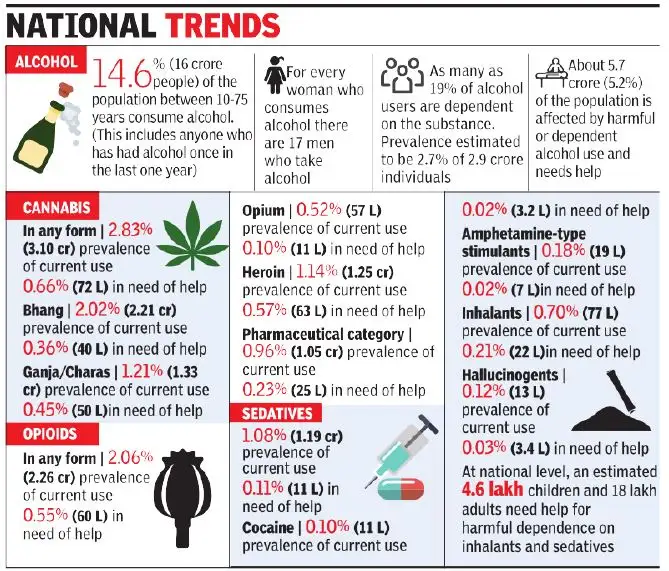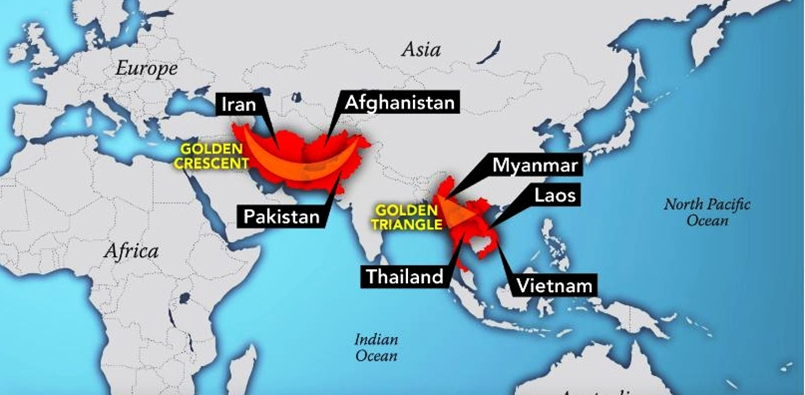Facts for UPSC Mains
Towards Drug Free India
- 23 Aug 2025
- 6 min read
Why in News?
India is grappling with an escalating drug abuse crisis. The Nasha Mukt Bharat Abhiyaan was launched to address this issue and has now completed five years of implementation.
Nasha Mukt Bharat Abhiyaan
- About: Launched on 15th August 2020 by the Ministry of Social Justice & Empowerment.
- It aims to raise awareness on substance use, focusing on educational institutions, universities, and schools.
- It targets the identification of dependent populations and strengthens counseling and treatment facilities.
- Initially focused on 272 vulnerable districts, now extended to all districts in India.
- 3-Pronged Strategy: Three-pronged strategy—supply control, demand reduction, and medical treatment.
- Key Achievements:
- Mass Sensitisation (18.10+ crore people, 4.85+ lakh institutions)
- Youth Mobilisation (1.67+ crore students, pledge & events)
- Digital & Tech Integration (social media, website, app, geo-tagging)
- Volunteer Network (20,000+ Master Volunteers)
- Community Outreach (campaigns, monitoring, awareness drives)
- Collaborations (MoUs with spiritual/social organisations including The Art of Living, Brahma Kumaris, Sant Nirankari Mission, Ram Chandra Mission (Daaji), ISKCON etc).
Prevalence of Drug Abuse in India
- Drug Addiction: Around 10 crore people in India are affected by narcotics (NCB data). States like Uttar Pradesh, Maharashtra, and Punjab recorded the highest FIRs under the NDPS Act (2019–2021).
- Major Consumed Drugs: According to the National Survey on Extent and Pattern of Substance Use (2019), about 16 crore people (14.6%) aged 10–75 use alcohol, while 3.1 crore (2.8%) use cannabis.
2 Major Drug-Producing Regions in World
- Golden Crescent (Afghanistan, Iran, Pakistan): Major opium hub affecting J&K, Punjab, Himachal Pradesh, Rajasthan, and Gujarat.
- Golden Triangle (Laos, Myanmar, Thailand): Key heroin-producing region (Myanmar approx 80% of global supply), with trafficking routes passing through India, making it a vulnerable transit and consumption zone.
What are the Key Challenges in Drug Control India?
- Mnemonic: DOPE
- D – Dark Net & New Substances: Rise of new psychoactive substances and illicit online trade using darknet and cryptocurrency.
- O – Organizational & Infrastructure Gaps: Lack of trained personnel, forensic labs, rehab centers, and specialized facilities.
- P – Poor Awareness & Prevention: Inadequate education, weak community-level awareness, especially in rural and youth populations.
- E – Exclusion & Stigma in Addiction Treatment: Social stigma and high demand discourage rehabilitation, limiting control efforts.
What Measures Should be Taken to Eradicate Drug Abuse in India?
- Mnemonic: SAFE
- S – Strengthen Law Enforcement: Enhance NDPS act, 1985 & Prevention of Illicit Traffic in Narcotic Drugs and Psychotropic Substances (PITNDPS) Act, 1988 implementation with adequate resources, training, modern equipment, robust intelligence & surveillance, and inter-agency coordination.
- A – Awareness & Prevention: Expand treatment and rehabilitation facilities, strictly following National Action Plan for Drug Demand Reduction (NAPDDR) for awareness campaigns on de-addiction, and rehabilitation.
- F – Focus on Supply Reduction: Improve border control, use advanced technology such as AI, Big Data, drones, satellites, and online citizen reporting systems, support alternative livelihoods for illicit crop farmers (e.g., Jharkhand poppy scheme), and intercept supply chains.
- E – Enhance International Cooperation: Collaborate with neighboring countries, UNODC, Interpol to track and prevent drug trafficking.
UPSC Civil Services Examination, Previous Year Questions (PYQs)
Prelims
Q1. Consider the following statements: (2019)
- The United Nations Convention against Corruption (UNCAC) has a ‘Protocol against the Smuggling of Migrants by Land, Sea and Air’.
- The UNCAC is the ever-first legally binding global anti-corruption instrument.
- A highlight of the United Nations Convention against Transnational Organized Crime (UNTOC) is the inclusion of a specific chapter aimed at returning assets to their rightful owners from whom they had been taken illicitly.
- The United Nations Office on Drugs and Crime (UNODC) is mandated by its member States to assist in the implementation of both UNCAC and UNTOC.
Which of the statements given above is correct?
(a) 1 and 3 only
(b) 2, 3 and 4 only
(c) 2 and 4 only
(d) 1, 2, 3 and 4
Ans: (c)
Mains:
Q. India’s proximity to the two of the world’s biggest illicit opium-growing states has enhanced her internal security concerns. Explain the linkages between drug trafficking and other illicit activities such as gunrunning, money laundering and human trafficking. What counter-measures should be taken to prevent the same? (2018)









